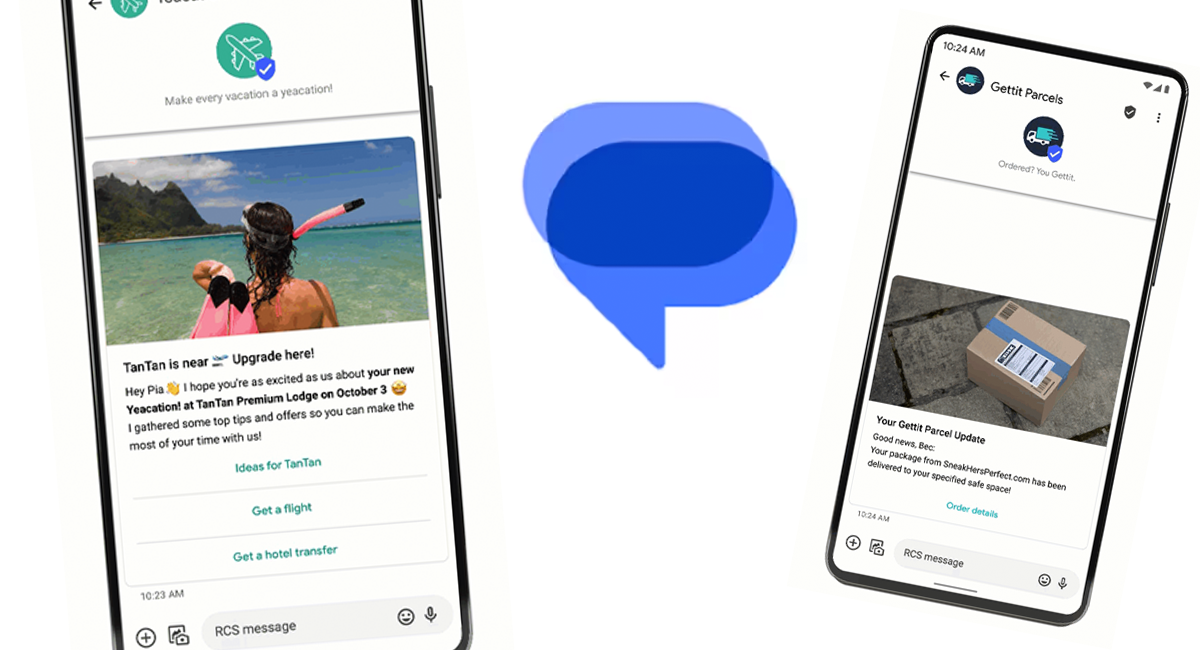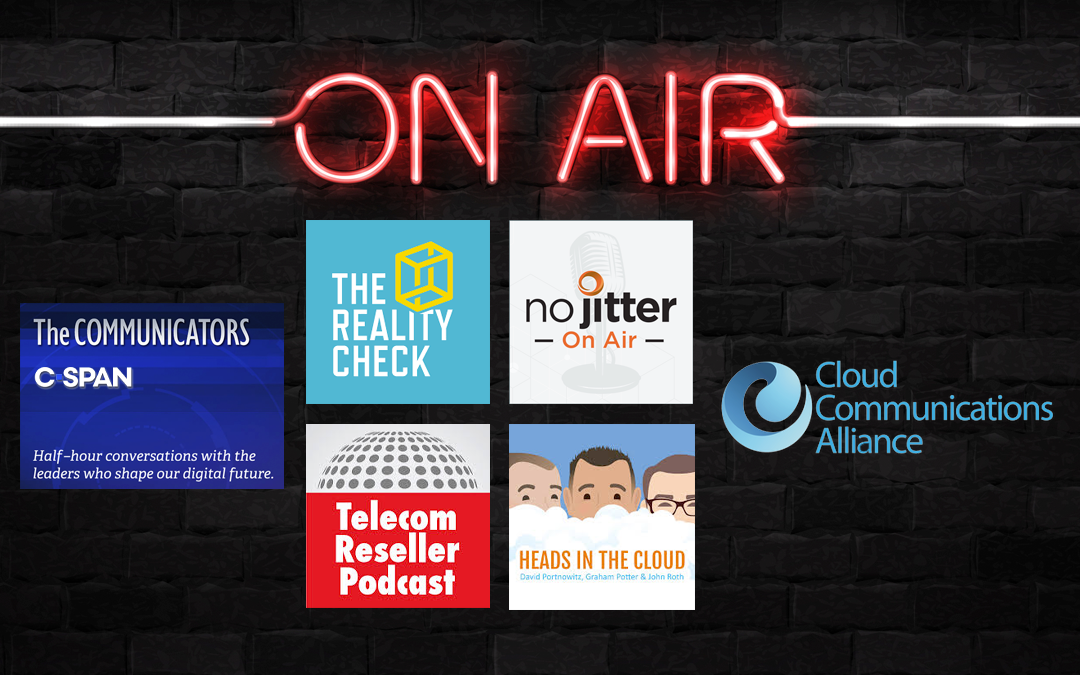Although the percentage of successful long code (10DLC) messaging campaign registrations has increased, there are still a significant number of rejections—even as the rules continue to evolve and the fees pile up.
It’s enough to make senders reconsider using text messaging at all, but the 98% open rate and the lure of “local” numbers can’t be matched with any other form of communication. So what to do?
As Commio’s Customer Success Director, Katie Reddick and her team work with dozens of customers to address these issues every day, and she’s happy to help! In this Telecom Wise Guys video, she’ll walk you through:
- Know before you start—make sure your use cases are acceptable (they’ve changed!)
- How to register brands successfully–and what can trip you up
- Step-by-step instructions to successfully register campaigns the first time, every time
- The 15 most common reasons for rejections (#3 will shock you!)
- See our helpful hints and rollovers throughout our commio.io platform to maximize your odds of success
Watch now and put campaign rejections in your rear view mirror.
Webinar Questions & Answers
Q: How long is the approval time for sole proprietors?
A: Commio has not had many requests from sole proprietors and because this category is often used for illicit messaging we do not anticipate adding this option to the Commio platform.
Q: Have you seen any sort of franchise rejections? What if somebody tries to register a number of locations for franchisees, franchisors?
A: We’ve had customers do it both ways. We’ve seen it work when they registered a single brand for the main owner and then registered a single campaign using phone numbers from the different franchise locations. Lately, however, The Campaign Registry has been stricter about ensuring entities are separate, so it might be best practice at this point to do each individual location as its own brand and campaign. But we do have at least two different customers using a single brand for the main legal information and then a single campaign with the shared phone numbers.
Q: I’ve seen issues where, if the main franchisor has a privacy policy that says that they share data among, say, pizza locations—apparently Little Caesar’s does this—then the response is, “Lead generation affiliate marketing is prohibited, unable to verify, need websites.”
We can go look that up for you and figure out what the current thinking is. Commio has direct contacts at the TCR we’ll reach out to after this call for feedback, James, and I will get back to you one-on-one.
Q: Are we able to change the connectivity partner once the campaign is approved?
A: The connectivity partner cannot be changed. If you have a campaign set up with a provider and you’re sending it through them, you would have to recreate the campaign to choose a different provider. If the campaign is already approved it should get re-approved quickly.
Q: Is the drop-down list of opt-out messages <shown in the demo> built into the portal that way, or is that because you’ve typed them in there previously?
A: These were sample messages we typed in, but we’ve requested that the Product team add them as a pick list.
Q: Can the Opt-in be accessed via a hyperlink or does it need to be fully written out on the web page that also collects the phone number?
A: Opt-in information must be fully written out on the web page that is collecting the phone number. You cannot link to another page.
Q: Do we have to update the sample message every time we change up the message throughout the year? How would somebody do that?
A: You need to make sure that if the campaign is registered as a marketing use case, for example, you are only sending marketing messages. If you change the message—”we’re running a new special” for example, or even if the product name were to change—you don’t have to change the sample messages; you just need to ensure the content is still within the same use case. If it’s a different use case, you need to create a new campaign.
Q: How long do campaigns last? And what happens when a campaign ends? How long does a campaign live on? Because sometimes it’s a timely thing, like you only do something like in November. How does that work?
A: When a campaign is first created it will always be billed for the first three months. Campaigns are set to auto-renew each month after that, unless you choose to deactivate it. Deactivating a campaign will stop it from being billed, but of course it will always be billed for the first three months.
Q: Would we be notified prior to [a campaign’s expiration] or how does that work?
A: The Commio portal doesn’t notify you. You can always go into the portal and go to and see the dates there. We’ll share this suggestion with the Product team.
Q: Once somebody resubmits [a rejected] campaign for review, does it go to the back of the line as if it’s starting over? Or does it get some priority for review?
A: It goes to the back of the line. But if you tell us at Commio that you resubmitted it, we can get The Campaign Registry to review it more quickly. We send emails several times a day saying, “Hey, this customer fixed the problem and here’s the resubmit. Can you look at it instead of letting it sit in the queue?”
Q: I have customers who just use text to interact one-on-one and aren’t using campaigns at all, but this process has now paused all of my customer’s SMS because it makes it impossible. Is there a workaround for non-campaigns—just regular usage between handsets?
A: Commio is A2P; we do not have a P2P rail with the providers. It’s all A2P and unfortunately because of that, it all has to be registered. We’ve helped a couple customers with this and it’s really unique to how the messages are being sent.
If you’re in this situation, set up a call with Commio to go through your Use Case. If it’s going through a messaging platform—if your service is a messaging platform—we could register your company and then do a mixed use campaign for your users. If it’s hitting a separate messaging platform—if your end users have their own—we would have to do those individually as well. It also depends on how many numbers you have. But there are options to set it up.
Q: Are we required to respond with opt-out confirmation whenever somebody texts back ‘STOP’?
A: You don’t have to reply to the stop, as long as you remove them from your list(s) going forward, but best practice would be to confirm directly that they are opted out.
Q: How can we ensure the STOP is working on behalf of customers?
A: If a Stop is sent, Commio will no longer allow messages. However, you also want to ensure you are removing that customer from all lists on your side.
Q: Can separate campaigns be linked to the same 10DLC number, or is it one campaign per number?
A: A phone number can only be tied to a single campaign ID. A single campaign can have up to 49 numbers assigned to it. If you have a scenario where you need more than 49 numbers, you’ll want to split that into more than one campaign and use some kind of way to differentiate. Whether it’s different departments or different regions, there has to be some differentiator to prove the need for more than one campaign.
Q: Is there a link to see all of the fees?
A: Yes! Commio publishes all of them on our Texting Fees & Surcharges page.
Q: Do you have to pay again if your application is rejected and then resubmitted?
A: Unfortunately, yes; that’s why we encourage everyone to know the rules and get it right on the first try as often as possible.
Q: Can the Opt-in be accessed via a hyperlink or does it need to be fully written out on the web page that also collects the phone number?
A: The opt-in language must be written out on the page collecting the phone number. You cannot have them go to another page to read the opt-in.
Q: How do you handle opt-in if you are texting to a patient in an existing PMS (appointment confirmations)?
A: If you have already gathered their information without an opt-in, we would highly recommend sending some type of follow-up confirming their opt-in to the notifications. If they gave opt-in consent when they signed up or verbally accepted when they provided their phone number, you are covered.
Q: If the opt-in and online statements are within a portal that requires log-in, how is that information verified?
A: It is best practice to screenshot that page behind the login and provide it on the campaign in the multimedia section. You would also want to clearly explain where the customers are going to opt-in in the Call-To-Action section of the campaign.
Q: Is there a limit to the number of campaigns that can be registered to a brand?
A: Most of the carriers have a limit of 50 campaigns tied to a single brand. The reason for that is they want to make sure there’s no snowshoeing. That’s half the reason behind all of this to begin with, and the reason why you can only have 49 numbers tied to a single campaign. It’s been suggested that most companies would not need more than 10. There are Use Cases that would need more campaigns, but there are only so many Use Cases, and there are really only so many reasons for needing that many phone numbers.
Q: What is snowshoeing?
A: Snowshoeing is a technique used to spread messages across many sending phone numbers, or short codes, for the purposes of overcoming carrier filtering systems.
Q: Can you speak on the non-profit registration process? We have been told that we need a dedicated SMSC port for each non-profit organization. Our communications platform does not allow for this. Are you familiar with this and is there a workaround?
A: You can register a non-profit organization and campaign with Commio at this time, but it will still be charged the carrier surcharges and ultimately be treated as any other campaign type. If you have a true non-profit and wish to avoid the surcharges please let us know. We are in the process of setting up a separate bind for these types of campaigns.
Webinar Transcript
TIM: Welcome to our webinar, Telecom Wise Guys, from Commio. One of the things that we pride ourselves on is providing educational resources like these webinars to both customers—which is a huge focus of this one—but also to anybody out there in the messaging space who’s contending with the current compliance regime.
When I first got involved with text messaging almost five years ago now, it was not at all like it is now. We were able to almost run traffic unrestricted through the different channel connections that we had. And over the years, the carriers themselves, along with other regulatory bodies and the direct carrier aggregators, have gotten their stuff together to the point where there’s been some—I guess we could call them roadblocks, Katie—necessary steps along the way of getting any traffic delivered to the carriers to try to prevent things like, robo-texting and just really in general bad texts being attempted and, or delivered to the handsets. So with that in mind, I had to get Katie Reddick, who’s our Director of Customer Success, on this webinar. Katie, welcome in.
KATIE: Yes, thank you for having me. Lots to talk about.
TIM: Yeah, Katie and her team here at Commio are spending a lot of their time and energy working with our customers who, maybe they’ve been doing 10DLC long code messaging in the past, maybe they’re new, but there’s a whole new thing in place called the campaign registry that has taken over, sort of that intermediary step between, “Hey, I want to send texts on behalf of X brand, and I want to deliver these campaigns. How can we get those registered in a way that has some sort of a compliance check to make sure that all the necessary steps are in place, to verify the quality of that traffic, ideally ahead of time so that we can sort of trace things back to their origins and just make sure that the whole ecosystem gets cleaned up?”
But I think the reason, Katie, that people have joined—and we’ll get to all the tips here in just a moment—is because anybody who’s interfaced with this process has had issues, and unless you follow the steps that we’re about to share with you, there’s a really good chance that your campaign and your brand registrations are going to be, or are currently being rejected. Right? So, Katie, you and I looked at these, and I’ve been looking at them for a couple months now; we’re seeing on average anywhere from 40 to 70 percent rejection rate on these registrations. Does that hold up to what you’ve been seeing?
KATIE: Yeah, it does. And we want to improve that, but even with the rejections, we may come back and fix a problem and then it still gets rejected. So we want to make sure that we’re educating people on all the different things being checked, so it’s not this process of reject, reject, reject over and over.
TIM: Right. And I would start by saying too, that you and I would both agree, we don’t want any rejections.
KATIE: That’s right!
TIM: And it’s as big of a headache for us as it is for you as an end customer, I would say. But if you follow the steps that we’re about to share, I think you’ll find that if you take a healthy breath and you dot your i’s and cross your T’s and follow this process, and ideally put it in the hands of somebody who potentially isn’t the technical owner of these campaigns, but the content owner or the compliance owner and look at it with sort of that eye, and don’t look at it as another sort of hurdle on the way to getting your text messages delivered to the handset, but as an opportunity to make sure that you’ve got the right things in the right fields, that things are properly verified, and that you’re following the steps, and this will become a non-issue very quickly. So with that, I know we’d like to keep these webinars to 20-25 minutes, so let’s see if we could make that goal this time around. As much as I’d like to chat, as you can tell, but let’s start.
So again, I don’t think anybody would be surprised with this, Katie, just why is text messaging so popular? Look, I’m a marketing guy. I’m the director of marketing here at Commio. I am addicted to email. But you know what else I like better nowadays, is text messaging. Because if I can get a 20% open rate on my email campaigns, that’s praiseworthy. But text messages, 9.9 outta 10 of them are open within three minutes; you can’t beat that.
And as I mentioned earlier, the compliance requirements have gotten very complicated. They’re becoming more expensive, not less as time goes on. And I think this might be a bit of a misnomer by the way: 10DLC feels like it’s the most stringent, but I would say that all three flavors of texting are fairly equal in terms of the lift on the front end now. Toll-free has its own hoops you have to jump through. Shortcode is still the hardest to get, but once you’re thoroughly vetted, that’s where you can get the most sort of consistent delivery. But nothing beats—I think you would agree, Katie—having local phone numbers delivered. Especially if you’re a local business, or a local brand, long code 10DLC is worth the trouble.
KATIE: Yes. And I mean as you said, really at this point for a while there toll-free did seem to be easier, but at this point they’re all checking the same things, which of course we’ll go through. So, there’s definitely a benefit to having local numbers for certain businesses.
TIM: And it’s important to tell the audience too, I think a lot of people, once they saw the writing on the wall, when the TCR was in full swing, people were just running for toll-free. But now that toll-free has made the changes that they’ve made in the last few weeks/months, basically the way to think of it is, the days of unregistered text messaging are over. So you’re going to have to go through the registration process for any of the types of text messages going forward. So it’s important to know what those tips are, follow these tips, and hopefully, we’ll reduce those rejections.
So the first thing, and Katie, you know, we’ve said this a million times, is you have to check your Use Case. So that’s something that we do. By the way, at Commio you and I both know, Katie, we work hard to know our customers. So KYC, if you Google it, is a big theme in cloud communications today. And it’s because we need to know who wants to send calls or text messages and make sure that we’re not contributing to illegal robocalling or any of that kind of bad traffic. So when it comes to texting, it’s the same thing. The first thing you want to do is check your Use Case. So it’s the usual, they’re called SHAFT: you can’t send any texts about sex, or hate, alcohol, firearms, or tobacco, you see them on the screen. And just remember that when we say tobacco, we also mean cannabis, right? So, that is also included. And that list is constantly evolving. So, Katie, I know you and I both, have updated those lists several times.
KATIE: Yes.
TIM: And by the way, they’re adding things; they’re not taking things away. And I think the newest edition—Katie, I feel like I’m doing all the talking and I’m sorry, I’m passionate about this stuff—is that if you’re at all involved in third-party lead generation of any kind, you’re probably not in luck anymore. So that’s why a lot of folks who are using third-party data are now having to develop their own properties to get first-party data so that they’re able to send texts. But it’s just part of the changes, right?
KATIE: Exactly. Yeah, the third-party stuff, and I’ll mention it again when we’re running through the list, but that is one of the words that they are basically scrubbing your website for, they are making sure that nowhere in there does it say that you’re sharing the information with third parties.
TIM: That’s exactly right. And I was going to say that—again, we’re going to go through when we go through the steps—one of the biggest misses is, people are not updating their privacy policies to say that they’re not going to reuse, or use third-party information, or resell your information. Because they actually look at your privacy policy now on your website.
And by the way, really want to recommend to anybody who has a smartphone out there, to pick it up right now and, hover over that QR code over there because we do have a really good ‘SMS Use Case’ eBook that will go even more in-depth into these roles. So, we’ll share these also at the end. But if you’re watching this after the webinar or now, go ahead and scan that, grab that eBook through that link and that’ll give you even more details on the Use Cases that are allowed or disallowed. So let’s continue.
Number two is brand registration. And Katie, it’s still amazing to me because we see it all the time, is that if you’re the provider of text messaging services, remember you’re never registering yourself as the agency, you’re registering your client. So we see time and time again, people who are new to this, they’re like, “Oh, well I’m the one texting. I’m just making up that company and I’m going to register myself to send on behalf of my customers.” That’s not the case. If you’re going to help your customers, if you’re reselling this as a service, you’re registering your clients, not yourself. So that’s the first mistake a lot of them make.
KATIE: Definitely. These bullet points walk through this, but you definitely have to have the correct information from your customer. It’s not something unfortunately that you’re just going to be able to guess. It is checked against the legal information on file. We’ve had, especially in the beginning, people who knew their customer name and their address, but maybe they didn’t have their tax ID. You really can’t get around it. It’s going to be checked. So you do want to verify this information with your customer so it gets approved right away.
TIM: There you go. That’s right. And we say here that approval or denial is almost instant. I feel like they’ve gotten better with that, it used to take a couple of days till we heard back. But you know, in general, Katie, if somebody’s looking at this process and working with somebody like us, how long in general do we see that these approvals are taking these days?
KATIE: So it is different for brands versus campaigns. Brand is where you’re going to enter the legal company name, there’s a DBA, you’re going to enter the address and of course the EIN number tax ID. As long as all of that is entered correctly, the brand is an automated check. So it’s checking, is that what is in the legal database? And as long as everything matches exactly, within a handful of seconds you’ll see that your brand is approved and ready to go.
Now what slows down the brand registration process is, let’s say you have a mistype in the name, or maybe you left off the Inc. or the LLC, that can cause it to not automatically get reviewed. Sometimes we do have situations where like if you’ve gone through a recent acquisition or something, it could be old information on file. There is a way to dispute any kind of unverified status if the information you entered is correct. But anything that does not automatically hit and get checked, it does take some additional time to get it reviewed and approved.
TIM: Makes sense. I think it’s important: If I were a compliance person or if I worked for one of our customers, I’d say the first thing I need is IRS form SS-4 CP 575, right?
KATIE: Yes.
TIM: There you go. We need this form. And when you’re registering that brand, make sure that you’re using that information. Great.
KATIE: Exactly.
TIM: Makes sense. And obviously guys, their information comes first, and afterwards you’re going to have to identify yourself as the agency that’s working on behalf of them. So it ties everything together in that registration. So this is what it looks like in our platform, right, Katie?
KATIE: Yeah, so this is just one I have built out on the demo account. I went through the process, I added our legal name, our DBA, and our information as far as the legal address and everything and it came back immediately. If I had entered something slightly off, it probably would’ve immediately come back with an unverified status. But this is the information you need. If you’re not getting those actual legal forms from your customer, if you want to make your own kind of form or whatever that may be, this is the information.
One thing that’s really important here as well is going to be that support email and the website need to match this company. So we’ve had people where they list their customer’s information, but then for the support email they listed their own company email and website. And that’ll get rejected. They want to see that it actually matches the customer that’s being submitted on the brand.
TIM: Got it. And Katie, we’ve got our first question. I think it’s a good one because we’ve had to talk about this in our materials: Claire is asking how long the approval time is for sole proprietors. Have you seen any of those come through for us?
KATIE: It should be a quick turnaround. We current don’t support sole proprietor submissions, but are working to update our system as of November 1, 2023. I know in this situation you don’t have a tax ID, so they’re not going to be checking that. It should be an automatic verification. Unless you just left something blank or something like that. But if you have problems with it, definitely let me know. But that one should be an almost immediate turnaround on the brand.
TIM: Yes. And I know that James was asking a similar question and obviously guys, if we don’t have the answer we will get back to you, but he was asking: How do you register a sole proprietor for a brand? I know sole proprietors have been a topic of conversation through Twilio months ago. Again, I’m not sure we have too much experience with sole proprietors at this point, at least on our side.
KATIE: Right. I know we don’t have a whole lot, but one thing I do know is for the sole proprietor, the tax ID is of course not required. We’re working to update our portal so when you select sole proprietor, that tax ID field just grays out. (More to come on that as of November 1, 2023.)
TIM: Gotcha. And another question from James as well, and I’m not sure: Have you seen any sort of franchise rejections? If somebody’s trying to register a number of locations for franchisees, franchisors?
KATIE: We’ve had people do it kind of both ways. It is a best practice at this point to do each individual location as its own brand and campaign. But I do know of at least two different customers we have, that have a single brand for the main legal information and then they are doing a single campaign with the shared phone numbers.
TIM: Yes. James mentioned that there have been some issues where, if like the main franchisor has a privacy policy that says that they share data like pizza locations—like apparently Little Caesar’s does this—and then it comes back, “Hey, lead generation affiliate marketing is prohibited, unable to verify, need websites.” So as somebody who’s worked with franchise arrangements for furniture, mattresses, and appliances in my former gig, I totally understand why this would be a roadblock. So, we can go look that up for you guys and, and figure out what the current thinking is. And by the way, we do have direct contacts at the TCR that I’ll make sure to reach out to as soon as we’re done with this call to ask for their feedback, James, and I will get back to you one-on-one.
KATIE: Yeah, these questions are great because it is changing so rapidly, so something that worked or was best practice a few months back, could be different now. We definitely want to make sure we’re sharing the most up-to-date update on what’s best practice.
I do want to mention, if you are your own CSP (communication service provider like Commio) or you’re working directly with The Campaign Registry, if you get us your CSP ID—and I can always show you where to find that in their portal—we can add that to your Commio account and that will pull in any campaigns that you choose us as a connectivity partner on. We just have to have that CSP id so we can link things up.
TIM: Awesome. All right, moving on. So now we’ve got the brands taken care of, hopefully, now let’s talk about the campaigns.
KATIE: There are a lot of things that are checked specifically on the campaign submission and then those kind of go hand in hand with your website. One of the ones that you’re going to see here a few times is going to be the opt-in process. They want to know where our customers opt-in, and this means the end user. Where is the end user opting in? When are they doing it during the process, and how are they doing it? And those can vary from company to company. Some people have it on their website. Some people might have a physical location where someone’s walking in the door. It could be part of a sign-up process within like an NMSA, or a form where you’re actually agreeing to the account. There are lots of different options. So I just like to keep in mind the Where, the When, and the How is what they need to see in the call to action.
And call to action, you’ll see that abbreviated as CTA. I know we’re trying to get better about actually spelling it out, but if you ever see ‘CTA’ it’s the call to action.
TIM: You got it. That’s right. And we mentioned here too as always your privacy policy, which means you need to make sure that your privacy policy has been updated with the statement that basically defines what you’re doing with user data, how you’re collecting it, and explicitly saying that you’re not reselling it. Because if they see that you will be instantly rejected.
KATIE: Yes, and what I always recommend, I mean this is what I do and what my team does if you guys send us websites to look at for you, is pull up the privacy policy. I do control F and I’m looking for the keywords share; phone; and personal, just to make sure I’m not missing anything in there talking about sharing with any third parties or anything like that. And nothing around selling or sharing the personal information collected.
TIM: Yes. And I’m going to jump the gun a little bit and say, Katie, that when we start to talk about these legal policies that are on your website, Katie and I are not telecom lawyers. But we know that a lot of you do have your own sort of legal resources for your company, they are the best ones to vet any part of this process that has a legal component, including the wording on these policies. So I know we have some examples in our eBooks of some of the wording that has been used for approval, but at the end of the day, you really want to make sure your compliance person or your or your lawyer’s taking a look at this stuff.
So before we go into the portal demo here a little bit for the campaign registration, James is asking: Are we able to change the connectivity partner once the campaign is approved? Good question.
KATIE: So you cannot change it. If you have it set with a current carrier and you’re using it through them, unfortunately you would have to fully recreate it to choose us as the provider. If it’s one you’ve already had approved, it should get approved quickly, but you would have to create a completely separate one to be able to choose us. That’s a great question.
TIM: Yes. And again to reiterate too, so we asked how long the brand registration typically is taking but what about campaigns? How long are they taking to get approved?
KATIE: So it definitely fluctuates and you’ve have to keep in mind that these are manually vetted. These are real people clicking through, reading the details, clicking on your website, reading those privacy policies. So normally, we see anywhere from two to four business days is kind of the average. I know recently there’s been kind of a spike and it’s been taking more like a week. That being said, reach out to us. Like Tim mentioned, we do have contacts at both TCR and the DCA. We can always lean on them if something really needs to get pushed through or if something’s been pending for longer than you think it should be, let us know. We definitely use our contacts over there and get anything like that pushed through when we can.
TIM: Thank you for that. Ronald had a great question too is: How do we handle opt-in if let’s say we were doing this on the customer’s behalf. How do you handle opt-in if you are texting to a patient in an existing PMS, or patient appointment system?
KATIE: So typically with those, there is going to be at some point where that phone number is collected. If that is, I’m trying to like think at my doctor’s office, I know I had to fill out a sheet with all of my information, and on the phone number section, it should include language, whether it’s a paper form or a digital form, it should just include language that by providing that phone number, you’re opting into text message updates about appointment reminders, things like that. Some doctor’s offices, they might use like a web portal where you go to sign up. So no matter where they’re capturing it, as long as you’re explaining, even if it’s in person, you could say the first time you visit this office for your first appointment, they will gather and verify your contact information and ask you out loud. Do you want to opt in to text updates?
TIM: Yes. That’s what happened to me. My dentist and also my general practitioner, they both gave me another sheet to fill out when I went in for an appointment and that’s what it was, and I gladly gave them my information with that legalese attached, that they were just going to send me those in that information. So, pretty easily handled as long as again, you can detail that during the opt-in process. All right.
So I’d love for you to take us through. So this is our Commio.io platform version of campaign registration. So once you get in here, Yes. Oh, I’m sorry. Were you going to share live?
KATIE: Yes, I am under the messaging campaign registry section. I know some of you may do this via the API, anything I show you here in the portal it’s the same steps, if you’re doing it, and same information collected. We already went through kind of the brand setup.
The next step is going to be your campaign. You can add a new campaign and then the first thing it’s going to ask you is: Which brand are you linking it to? I’ve got two test ones in here, so I’ll just pick Commio. From there you have all of your different Use Case options. So whether you’re doing it for customer care alerts, or maybe it’s it’s marketing, there’s also going to be this mixed option. So maybe I’m using the same campaign and same phone numbers for marketing as well as account notification. You can choose multiple options there. Some customers choose to split them out. If you’re using different phone numbers, you may have a campaign for marketing, a campaign for two factor authentication, and a different campaign for just your customer care. So it really depends on are you using the same phone numbers or not?
And how many phone numbers do you need associated with each?
So the next page is just going to show you the carriers. If you’re sending to all of the carriers, which I’m sure all of you are, just go ahead and click next.
And then here we get into the details that are going to be heavily reviewed when it goes through that review process. So campaign description, there is a character limit here, so it wants to see at least a full sentence of what this campaign is being used for. Let’s say I was setting it up for 2FA I could write there; this is the campaign being used to notify our customers of their two-factor authentication code when they go to access our customer-facing portal.
Call to action or CTA: This is again, the where is it happening, the when, the how. So you could say here, my customers or potential customers are going to our website, they’re clicking get a demo, they’re providing their information. That page of the website includes the opt-in or the consent to be contacted by text message. They will go check your website, whether you say it’s happening on the website or not. So even if you’re collecting, let’s say, it was a doctor’s office and you’re collecting it in office, in person, or via a form, they’re still going to go to your website. Any page that is asking for a phone number does have to include the opt-in language, even if you’re gathering or capturing the opt-in outside of the website as well. So this is a really big one. Just try and be as detailed in explaining how the end users are opting in. That one gives us a lot of rejections as people just throwing in a sentence and it not really explain the kind of where, or how, and when.
And then you have the subscriber opt-in, opt-out, and help. There are some examples in here of messages, but you can also type your own if you’re using a unique message. They just want to make sure that you are including those options for opt-in, opt-out, and of course help.
TIM: But if you really want to make sure that that gets approved, pick one of them from our pick list.
KATIE: Yeah, exactly. Sample messages are pretty important as well. I always recommend at least two sample messages. Now, of course, especially if you’re doing, let’s say it’s a marketing campaign, you’re going to be marketing different things at different times of the year, different times of the month. It’s never going to be the same exact message over and over. That’s okay. They just want to see that your content you are sending is related to the Use Case that you’re registering here. So if I registered this as a marketing campaign and then I tried to use this as, “Hey, your account’s past due,” that’s not going to fly. So you do want to have whatever the case is, give those sample messages and then it can of course deviate from the actual sample messages, given as long as it’s the same kind of
TIM: Yes. Hey, Katie, can we back up a second? I’m getting some really wonderful replies. Like if you could click on opt-out message again. So are those built into the portal that way, or is that because you’ve typed them in there previously? Somebody’s saying, “No,” there’s nothing in your pick list. So if that’s the case let’s make sure we will include those Simon, in the email. And you know what, yes, I will talk with product about adding it.
KATIE: I do too. Yes. That’s funny. I really thought it was in there.
TIM: Well, because I know you do these all day long. I was going to say too that, you’ll notice guys look at all the red symbols throughout all these fields. We have built in a lot of form checking into our form and we add things to it all the time. So let’s definitely talk to Ashley about adding that in. I think it’d be a great idea.
KATIE: Yeah, that’d be great. We’ve got kind of at least, probably five or six for each one, that are just the kind of typical ones. So we’ll definitely get that built in. Thanks for catching that.
TIM: Yeah, great ideas. And by the way, I want to say too, I don’t know about you, Katie, if you agree with me, I hate the word sample message. It should be actual messages you will send.
KATIE: Yes.
TIM: Because people think sample, “Oh, I’ll just make something up that’s in the general neighborhood.” You want to get rejected, just go ahead and try to send stuff that doesn’t match your real message you’re going to send-slash-sample message. Because that happens all the time.
KATIE: Yeah, that’s a great point. Now, you don’t have to put any real customer information in there, you know? Use a generic name, whatever. But yeah, it should be what you’re actually using this to send.
TIM: Yes, now there is some wiggle room, right? Like sometimes product names slightly change. Those kinds of things will be tolerated. But we time and again, we see people that fill this out too early. They make this the first step in the process, not the last step, which is where it should be, and they get into all kinds of trouble down the road, right? And we don’t want to have to call you and say, “Hey, the DCA’s turned off your campaign today, because you’re sending something different than what you said you were going to send.” Please continue.
KATIE: No, that’s great. Yes. And so the other section that a lot of people are not taking advantage of this section, this sample multimedia. This can be a real game changer, especially if you’re having customers opt-in outside of just like a landing page on your website. You can never add too much information. So what we’ve seen people have success with this is, let’s say that your sign-up process is behind a login screen. You know, maybe you log into a customer-facing portal, or your UI, and that’s where you have the option to, I want to see text notifications for this, this, and this, and you have full control there. Someone reviewing your website is not going to see that because they’re not a user in your system. So take a screenshot, upload it here, and that way they can see it exists just because they don’t see it on your main website, maybe it’s behind a login or it’s an outside kind of form, go ahead and take a screenshot, upload it there, they’ll take a look at it, and that helps just clarify and fix a lot of confusion.
TIM: Right. Hey, Katie, before we continue down here with the links and things, two things. Number one is, and I feel like you can’t say this often enough, somebody’s asking: Do you have to pay again if your application is rejected and then resubmitted? The answer is yes.
KATIE: Yes, you do. We’re trying to definitely do things like this call, and get our eBooks and internal kind of documentation. We’re trying to get all the information out there so that you know what to check for. But you will get charged each time you have to go through it. So we want you guys to be successful.
We want to see first-time approvals, and we’re happy to look at your websites as well, as your customer’s websites. So send us an email. If this is your first time doing it and you want to jump on a call to walk through this together, we’re more than happy to do that. Really I would say call to action, making sure that that makes sense, on your website making sure that any page collecting a phone number has opt-in language on that page, and then double checking your privacy policy. But send it to us, our team’s looking at these every day. We’re looking at all kinds of different websites so we can always run through it and make sure that it looks good before you spend the money to submit it.
TIM: Right. I wanted to answer James’s really pressing question, which is a great question, which is: Have we heard the date of when all traffic needs to be registered? And the answer is it’s pretty much right now (October 27, 2023.) So we’ve been going back and forth with our DCA about unregistered traffic and we’re at the point now where, and correct me if I’m wrong, Katie, but if somebody comes on with us they’re able to send some very light test traffic unregistered before they register.
KATIE: We’ve actually been locked down on that now, we’ve had to change our testing process and this is such a big piece of success for our customers, that even new customers who are testing, we want them to go through this process. Because a lot of times, even people that may have done this a year ago, it’s a completely different process now as far as what they’re checking for, what they’re reviewing on the websites. So, you know, let’s get things submitted, we want to help you make sure they get submitted correctly. But if it’s not tied to a campaign right now for 10DLC, it unfortunately is not going to go out.
TIM: Yes. And one more question before I keep the other ones until the end, which is: Do we have to update the sample message every time we change up the message throughout the year? How would somebody do that?
KATIE: You do not have to do that. But what you want to make sure is that, if this is a marketing campaign that you are only sending marketing messages. If you’re changing it, we’re running a new special, or like Tim said, even if the name of a specific product were to change, you don’t have to go change the sample messages, you just want to make sure that the content is still within the same Use Case.
Now if you have been sending marketing and then you have a need for, well now we want to start doing, kind of like balance notifications or reset your password kind of portal support, I would go ahead and create a separate campaign for that. So if it’s a new Use Case, just go ahead and do a separate campaign. You can link it to the same brand if it’s for the same company, but go ahead and build that out in a separate campaign.
TIM: Yes. And Katie, I love this: How long do the campaigns last? And also, what happens when your campaign ends? How long does that campaign like live on? Because sometimes maybe it’s a timely thing, like you only do something like in November. How does that work?
KATIE: So I’ll show you on this page, we just have one campaign in this test account. Hopefully, you can see—I know I’m zoomed out a little bit—this was registered in September, and then most of these are on a three-month auto-renew. Now you still get the monthly MRC (monthly recurring charge) for that campaign, but most of them will auto-renew every three months.
Now, let’s say you only needed this campaign for a month, you don’t want to get charged for it anymore, so you would come in and actually deactivate it. There are times that these can expire, if it’s renewed so many times it will eventually expire unless you want to go in and make sure that you renew it. Most people though, they’ll build it out, it will continue on the auto-renew, and then whenever you’re done with it, you can just come deactivate it.
TIM: I also read Katie too, that every campaign has to have at least one phone number associated with it, right? Or doesn’t it get kicked out?
KATIE: Yeah, that’s a great point. And this is something that’s somewhat new as well, you don’t want to have campaigns that are just sitting there without numbers assigned. Once it’s accepted and approved, go ahead and get at least one number assigned. Otherwise it kind of falls into the state of a I can’t remember the word for it, but basically it’s an inactive campaign even though it’s active, and there are carriers starting to charge fees for those.
TIM: Dormant, right?
KATIE: Yep. There we go.
TIM: Exactly. And would we be notified prior to the expiration or how does that work?
KATIE: So right now, I don’t know that our system is going to notify you. You could always come into the portal and go to this section and see those dates there. You can also pull this information through the API, but that’s a great point. I don’t think we have any kind of notifications built out on like the renewal or expiration. So let me take that to our back-end team as well. I mean, this page has even changed a lot from when we first released it. So as we keep kind of learning these things and getting your feedback, we want to keep bulking this up so that all of the features and functionality are there.
TIM: Yes. Simon had a good question. You can’t add numbers to the campaign until it’s approved. So how would I add the number? I think what we’re trying to say is once you are approved, you want to make sure that you have at least one number associated with it.
KATIE: Yeah, right. So if it’s not approved, you can’t assign anything. But we’ve had scenarios where people have an approved campaign and they leave it sitting there and never assign their numbers to it, and that’s kind of the no-no that we’re trying to get around.
Keep in mind, too, just talking about when a campaign is billed, even if your campaign is rejected, it will still get billed monthly unless you either fix it and resubmit it, or deactivate it. So if there’s one in here and maybe it got rejected for it’s a high-risk financial service, they’re not going to approve it, go ahead and deactivate it, otherwise, you will still get charged for it sitting there.
TIM: And that was another question somebody had is: Do we charge the $15 vetting fee on the auto-renew?
KATIE: Not the vetting fee. The vetting fee is only when you’re submitting it to us who sends it to the DCA to be reviewed. So that would happen of course, on the initial submission and then if anything got rejected and you had to resubmit. The monthly fee, most of the campaigns it’s $10 a month, some have slightly different pricing based on the type. But that is a separate fee, separate than the DCA review fee or vetting fee.
TIM: I get it. Simon said, “Hey, I just resubmitted a campaign and the status didn’t change from declined on our portal.”
KATIE: One thing I’ll show you, well a couple things actually that reminds me of; if you go in let’s say like your CTA needed to be adjusted, if you come in and edit the campaign and then you save it, I think the button actually says submit, that has saved your change, but it is not re-shared your campaign. So once you’ve made the change, you’re going to want to hit this button that says Re-share Campaign, that should push it and then it should say pending.
Now one other thing that can sometimes happen is if we miss a web hook on the back-end, the DCA status may not be accurate. So if you think you re-shared it, but it’s saying, declined, click this update DCA status, this doesn’t do anything other than just do a refresh to make sure that the correct status is showing there.
TIM: Love it. Wow, Katie, this has changed even since the last time I saw it.
KATIE: Yeah, I know.
TIM: I’m so glad everybody’s on this call. This literally changes every week nowadays. So that’s great. Oh Simon says, “Hey, that worked. Thank you.” See?
KATIE: Oh, good. That’s awesome.
TIM: Katie, solving real problems in real-time.
KATIE: So basically, the only other screen that I didn’t show you guys was just the final screen that says, “Okay, this is everything you submitted, does it look good?” And then you can go ahead and save it. Now when you do that on the first screen the first time around and you click submit, that does go off and send it immediately. But if you’re editing anything later that’s when you’ll have to use the re-share button. But the first time, as soon as you fill it all out and click submit that immediately sends it off for review.
TIM: Got it. And Katie, this is just a question for me, which is: How many of our customers do you think are using the API versus our platform?
KATIE: I don’t know what the split is, I would say that people that have maybe been with us longer and they already have the API built out, I know they’re taking advantage of doing it this way. Some of our customers, especially if they’re newer or they may have been with us for a while but they’re just now getting into the campaign registry portion of it, they’re using the UI. So, like I said, either way it’s the same exact information being captured. So whatever is better for you is fine by us. And if you’re building out the API, I know I recommended this to somebody earlier this week, if your dev team is building out the API but they want to kind of click through and see the process, they can click through and act like they’re submitting a campaign without actually ever clicking submit just to get a feel for how the fields match up.
TIM: That makes sense. All right so, what are the top 15 reasons for rejections? I feel like we need a drum roll or something, but you’ll see some examples here on the right-hand side. But let’s go through them.
So number 15 is: We’ve said this already, the EIN, or the company name, or the other data doesn’t match with what they filed.
So, ‘Unacceptable Use Case’. We covered ‘SHAFT’, and by the way, if you go to our website and look under resources you’ll see there’s the surcharge and fees page for SMS that also lists some more of these where rejection types. No gambling, look at the SHAFT rules that includes cannabis, we mentioned before the ‘T’ you may think tobacco, it’s actually cannabis. Loan is not checked off on attributes. Again, you have to be really careful about third party lending and any loan type content. Company name doesn’t match email address. Email and phone number don’t match.
KATIE: So the EIN, I know when we talked about it, we were talking about it in regards to the brand. Keep in mind that your brand can get approved because the information you submitted can be correct and accepted. But then if you go and you register a campaign and it’s mentioning another company you could still end up having issues with them saying that the two don’t match. And then you would either need to go change the brand, or either change the campaign to match. Some of these other cases here, the stuff that’s not allowed—debt consolidation, things like that—sometimes it doesn’t call it out specifically. It is on our website, but anything like that, they can consider it a high risk financial service and and they don’t want to see those.
TIM: And by the way, really quick thing, I know Tony, you asked this question: Where can you go to see these fees? And also what Katie was just talking about, just a reminder, I already mentioned if you go to Commio.com, click on the Resources tab at the very top, you’ll see SMS fees and surcharges. If you open that up it’ll show you not only the surcharges and fees for SMS, MMS, but also these rules, as well as the campaign fees that we update. Just like our platform, we have to update probably two or three times a month, because the DCAs and carriers are sending us surcharge changes all the time. Not price changes, it’s easy for people to think. We’re not changing our pricing, we’re changing the surcharges and the fees that come from the carriers.
And by the way, one more question to you before we get past some other of these rejection reasons is: Once somebody resubmits the campaign for review, does it go to the back of the line as if it’s starting over? Or does it take some priority for review?
KATIE: That’s a great question. So it more or less goes to the back of the line. But if you tell us that you resubmitted it, those are ones that we can definitely get them to review again. Daily, we send multiple emails, “Hey, this customer fixed the problem and here’s the resubmit. Can you look at it instead of letting it sit in the queue?
TIM: Yes. And by the way, I think the great news is and Katie, I think we’re both privy to this on the back-end, but we’ve really been in direct contact with TCR. We have named people over there now that work with us one-on-one. I feel like we’ve got as good or better access than the folks even at Twilio do, and the other big players. We’re on an even playing field with them. In fact, we’re getting some acceptances faster than anybody else. So we have that one-on-one contact. So when these kinds of things come through, you work with Katie and her team and your account manager here, and we can help keep everything as fast as possible. We can’t promise anything, but we’ve had really good success and we’re seeing everything move in the right direction.
KATIE: Yes. And lately I’ve had a weekly call where some of these, that have just had weird rejections or like the website, it’s like, well maybe this is okay, but maybe it’s not, they’ve gone through those with me and specifically kind of pointed out what’s-what. So if we get stuck on something and my team doesn’t know how to help you fix it, we’ll go get the answers from the people who are actually vetting these.
TIM: Yes. And keep in mind too that obviously you could see in our platform, but also we see on the back-end every campaign that’s submitted through us, we see the reason for the rejection. So you can see that data in our platform, but like Katie said, we can always go back if we’re stumped, we can get on the line with them and figure out exactly what triggered, a refusal.
KATIE: Yeah, and they can always give us those rejection reasons, they’re of course kind of a catchall. So we can always go back to them and try and get more information on exactly what was wrong with your specific campaign or website.
TIM: Yep. Great. Let’s continue. So continuing the top 15 reasons for rejections. As we mentioned earlier, the agency is listed as the brand, not the client’s brand or brands. It still happens all the time. So I know Katie’s example was Commio, like we would never register ourselves, but that was just an example to give form. But just make sure that you’re registering your clients and their brands, not yourself.
Any webpage collecting a phone number needs opt-in language. That’s right. That’s one of the questions by the way we’ll get to later on, Katie, is sort of that whole process of how do you capture an opt-in and make sure that it’s legit. We’ll cover that in just a little bit. It’s an easy answer.
You’re missing website or incomplete call to action if opt-in process happens outside of the website. Again, just like you mentioned, use that upload button. If there’s an offline process that you want to show during the registration, you can upload that as an image and attach it to the application. And that would include, right, you would agree the opt-in process if it’s not on a website.
Missing or non-compliant privacy policy. The early days, people didn’t even have privacy policies. Now they have them but they forget to add the language, which is in our eBooks and in our materials about, “Hey, we’re not going to resell your information.”
Opt out language is missing from the message. It still astounds me this happens. It’s like stop-to-end. Right? And by the way, make sure that it works. I can’t tell you how many of these I’ve said ‘Stop’ to recently and nothing happens, and I’ve got an itchy finger to report them as spam. But true opt-out is working. At least tell me that you captured it, you don’t have to act on it right away.
KATIE: Yeah, there we go.
TIM: Opt-out language missing from the message from the website itself. And last but not least, sample message is inaccurate or the URL doesn’t match the website. The days of using a URL shortener like Bitly or all those things are gone. So you might have to work with your brands if they have a long domain name, which is really hard to put into a message. You might need to have them register another domain that’s smaller, just a few letters long instead, but still needs to direct to their main brand. So you have to make sure that the domain name and the brand are in alignment as often as possible.
Katie, we could do these webinars all day, every day and not cover everything. There’s so much to cover.
KATIE: I know!
TIM: Luckily our form does a great job of doing a lot of this checking before you even hit submit. And by the way, just a quick reminder guys that, we are just about to be over with, although we know it’s every single day, October is Cybersecurity Awareness Month. So just as a reminder, if you’re out there in the ecosystem and you have a platform that allows other people to log in, to set up these types of campaigns, and do anything in the communication space, just like us you need to really take a breath and make sure that you’ve got all the proper cybersecurity measures on your platform. We do hear of folks that have had their platforms compromised: The next thing you know at 2:00 AM somebody logs in and leverages an existing campaign, adds a bunch of numbers, and sends out a bunch of spam.
So do yourself a favor and make sure that your platform is hardened against cybersecurity intrusions. And it’s all these things that by the way, everything on the screen you’ve all seen hundreds of times, if not thousands. So it all starts with strong passwords. Turn on 2FA on your platform, whatever service you are offering to the outside world, recognize and report phishing, keep your software updated. And we will send you a link inside of the recording of this webinar, a link to our new eBook, which you probably have heard us talking about for the last four weeks or so, which is our ‘Essential Guide for Cloud Communications, Compliance, and Cybersecurity’. We really put them together Katie, we were doing two eBooks, and I said, “Let’s not do that. Let’s make it one”.
KATIE: Yes.
TIM: A big part of compliance in 2023 and 2024 is cybersecurity. So I want to remind you about that. And by the way, everything that Katie and I just talked about on this webinar is covered in this compliance eBook.
There’s sections on short code sections, on long code sections, sections on toll-free, and there’s a whole section on voice. Because again, we just did a webinar where we talked about STIR/SHAKEN, which was sort of the progenitor, is that my big word for the day? My $20 word for the day? The starting technology, that I feel like they’ve copied and pasted for messaging, from voice to messaging. And again, we could talk all day but I feel like at the end of the day, these early solutions are identifying all the players in the ecosystem. So when something potentially goes awry or is illegally sent, the carriers and the FCC have multiple companies to contact. I wouldn’t say throats to choke, but that’s pretty much what it is. So when there’s illegal robo-calls, we know here are the three whatever entities involved in this calling campaign and we can make sure that we roll those guys up.
It’s the same thing now with the campaign registry and messaging. So if we all take a breath and pretend we’re not part of this process, as part of the communications layer, it’s a good thing. None of us like to get junk text messages. None of us like to be reminded that our car’s extended warranty has expired, which I don’t know about any of you, but all those guys were shut down thanks to STIR/SHAKEN almost six months ago. I haven’t gotten one of those calls in a long time. So long story short, this is our eBook. We really want, especially all of our customers to have a copy of it because it really is becoming our updated bible to compliance going forward as all these things change over time. So again, you’ll get a link to this in the follow-up.
And great, so Q&A Katie, I can’t wait because we’ve got a lot of good questions in here. So let’s go through. By the way everybody, use either the chat or the Q&A button in your Zoom interface if you’ve got other things to add.
We said that all traffic pretty much needs to be registered literally as we speak. I mean, I think that toll-free technically expires November 8, 2023. I think that’s exactly when.
KATIE: Yeah, a few more days.
TIM: And by the way, it does take a good solid two to three weeks to get toll-free numbers in their proper positioning for use for messaging. So if you haven’t already done that, you’re a little bit behind the times. So reach out to your provider or to us, ASAP.
Let’s see. Simon, we’ve heard this question before. I’m curious, Katie, how you’d answer this: I have customers who just use text to text each other and not using campaigns at all, and this process has now paused all of my customer’s SMS because it makes it impossible. Is there a workaround for non campaigns, just regular usage between handsets?
KATIE: So it’s definitely a complicated answer because to start, unfortunately, we are A2P; it’s not unfortunately, but for this scenario you know, we do not have a P2P rail with the providers. It’s all A2P and then unfortunately because of that, it all does have to be registered. We’ve helped a couple customers with this and it’s really unique to how the messages are being sent.
So we can certainly, Simon, let’s set up a call together to go through your Use Case. If it’s going through a messaging platform, if your service was a messaging platform, that would mean that we could register your company and then do a mixed use campaign for your users. Basically if it’s hitting a separate messaging platform like if your end users had their own, we would have to do those individually as well. But we can definitely talk through how the messages are passing. There are options to get it set up, and it also depends on how many numbers you have. One scenario that I can think of is we have a customer who is truly doing P2P messaging, it’s their internal employees, like me sending Tim a message, “Hey, did you read my email this morning?” But we’ve had them register, depending on their company size, register the company itself, and then the campaigns can have up to 49 numbers per campaign. So if you’re a company that has a thousand employees that could be texting each other, there’s different ways to split it up. You could do it by department. So like I could have a campaign for the customer success team and then another campaign for the sales team.
If you’re kind of spread out all over or if it’s a Use Case where it’s regional, you can do, ‘this is my northeast phone numbers or users and this is my southeast’, there’s ways to do it, but we’ll definitely talk it through with you.
TIM: Interesting. I hadn’t thought about that. Yeah, if there’s a messaging platform in the middle, then you’re going to have to register. But obviously handset to handset, you don’t have to.
Tony asks a good question: Are we required to respond with opt-out confirmation whenever somebody texts back ‘STOP’?
KATIE: So what happens on our end is when we see the stop, we’re of course going to pass that to you so you see it as well, but at that point we actually stop sending the messages unless it is a confirmation message. Ideally, you should reply ASAP confirming the STOP receipt, then it’s up to you to take action on it. No reply to a STOP request leads to many people reporting your message as SPAM, which you don’t want. So always reply to a STOP with a confirmation message, be sure to code that in.
TIM: Yes. I feel like just as a consumer, I always want to see a response within 10, 15, 20 seconds max. Because otherwise my fingers get itchy and I want to send it to spam, which is not the right thing. Like I don’t do that that often, but if it’s the same company and they continually don’t honor my ‘STOP’, I’m going to report it to spam. And by the way, you don’t want that because I think, Katie, I’m not sure if you were privy to, we had a call about this, that we were told that any campaign that has over, what is it, a 0.5%, struggling to find my words.
KATIE: Opt-out rate.
TIM: Opt-out rate, then the carriers will flag it. So it only takes 3, 4, 5 in some cases of those to make them flag your campaign for additional review. You don’t want that. So you want to make sure you’re setting up your system to always reply as fast as possible to an incoming ‘STOP’ request, even if you don’t honor it immediately, maybe you only send texts every so often. However you process those, you want to make sure that you’ve got your back-end locked up.
How do we ensure the ‘STOP’ is working on behalf of the customer? I think that comes down to the platform that you’re running your messages through, right?
KATIE: Yes. So I mean, kind of like we just said, we are going to actually do our part to stop the messages at that point, but it is on your side up to you to then go clean up your lists. And like Tim said, it doesn’t have to be immediate if you’re not sending messages every day, but you want to make sure that on your side you’re getting that number or that contact outta there.
TIM: Yep. We answered the question about: When we resubmit does it go to the back of the line? The answer is yes. But if it’s special, you can reach out to us and we can solve it. Can separate campaigns be linked to the same 10DLC number or is it one campaign per number?
KATIE: So the phone number can only be tied to a single campaign ID. A single campaign can have up to 49 numbers assigned to it. And then if you do have a scenario where you need more than 49 numbers, you’ll want to split that into more than one campaign and just use some kind of way to differentiate. If someone needs more that 49 numbers on a campaign, they can do so. The 49 number limit only applies to T-Mobile and is the cutoff for the number pool process. If they need 50 or more numbers, they just need to go through the T-Mobile number pool process (outside of TCR). Keep in mind that the carriers MAY see multiple campaign to get around this as snowshoeing of campaigns.
So whether it’s, like I said, different departments or different regions, or maybe you’re doing it for separate locations altogether, there has to be some differentiator, just to prove the need for more than one campaign. But yeah, the phone number can only be tied to a single campaign.
Now if you are going to use that phone number for multiple Use Cases, you would just want to choose that mixed Use Case as your campaign type to make sure that you’re covered on all the content you’d be sending.
TIM: Excellent. This sounds tricky to me, maybe it’s not to you, Katie. We’ll see. Can the opt-in be accessed via a hyperlink or does it need to be a fully written out web page that also collects the phone number?
KATIE: So what I would say is, it can be via separate link. They’re still going to review the website. So that’s what we’ve kind of run into is people saying, “Well, this is the form they fill out. It has everything it needs.” They’re still going to go look at your website, so that’s fine if that is how the opt-in’s being collected, you can mention that you can provide those links or screenshots, whatever it may be. But they’re still going to go look at your website. We’ve had some people that had a section on their website where it was collecting a phone number, but they weren’t actually using that for anything. They were collecting the opt-in and the phone number elsewhere. Take the phone number off. If you’re not using it, just take it off or put the language in there, even though you may be collecting it elsewhere as well.
TIM: Perfect. Nicole’s asking: Can you speak on the nonprofit registration process? We’ve been told that we need a dedicated SMSC port for each nonprofit organization and our platform doesn’t allow for this. Are we familiar with this and is there a workaround?
KATIE: So this is something that we’re actually working or talking with the DCA right now on. And Nicole, I don’t know if it is due to your company asking about this or if we have someone else asking as well. We have at least one other customer that wants to get the nonprofits registered. It is a separate process, but we can help you with that.
So what we are currently doing is working to get a separate NN ID set up so that we can register nonprofits on that. We’re in the process of doing that, so it’s not something that’s live in the portal or anything like that, but we are working on it. So we haven’t already chatted with you, let me reach out and I’ll get us a call together with your account manager as well, because it’s something we’re definitely working on and we want to make sure we’re able to offer it.
TIM: Love it. And Marlena was asking if the opt-in and online statements are written within a portal once somebody is logged into it, how do we verify that information? And I guess I would take it to the next step, by the way, maybe not even so much verification, but it’s basically a matter of storing that, right? So we can prove that it was captured, right?
KATIE: Yes. Exactly. And like I said back on the campaign page, they’re not going to go verify it somewhere. They’re just going to make sure that you’ve explained it properly and that call to action and that they can go see it within the information you submitted. So if it’s behind a login, just send a screenshot of like, the form that people would be filling out. They don’t need a list of like your actual opt-ins, but just some kind of screenshot somewhere they can go validate it.
And I know I’ve mentioned this so many times, but I think one of the struggles that we’re really having right now is people, they’re sending the right opt-in information, they’re explaining how it happens, but then they’re not expecting their website to get vetted and fully reviewed to the capacity that they’re doing it. So just make sure that the website is accurate, that any page collecting a phone number has the opt-in language. If you don’t need to collect the phone number, take it out, and then make sure your privacy policy is, is up to date and compliant. And then that really will fix a lot of the issues with these rejections we’ve been seeing.
TIM: Yes. And I think whether our user is logged in or not, I think a lot of sites collect this information without being logged in. It’s just a matter of when somebody submits that information, there are ways to program the page to literally take a screen capture of what they just did, and then it timestamps it and it says, “Hey, they were on this page on this day at this time, and this is how they opted in.” That’s exactly what we’re going to ask you to provide if there’s ever a problem.
So you want to work with your web coders to make sure that no matter how you’re getting that information, you’re capturing it in a way that can prove date/time conversion. In fact, we even had a form on a site, it was really interesting, it was like name, phone number, you check the box ‘I agree to all the usual stuff’, and then there was a little box where you had to sort of like sign it, like you do an e-sign. They captured that too. I’m like, somebody who really wants to make sure that they’re never called out for somebody getting a text they weren’t supposed to get. Why not, if somebody really wants your text, they’ll do it. But I thought that was a cool one.
Is there a limit of how many campaigns could be registered to a brand? Good question.
KATIE: Oh, that is a good question. There are a couple of things to keep in mind. So most of the carriers have a limit of, you should not have more than 50 campaigns tied to a single brand. And the reason for that is they want to make sure that snowshoeing is not going on. That’s kind of half the reason behind all of this to begin with, and the reason why you can only have 49 numbers tied to a single campaign. 50 is a number that I’ve seen as a restriction, but I was reading something the other day and it was like, most companies would not need more than 10. So there are Use Cases that of course would need more campaigns, but there are only so many Use Cases in there, and there are really only so many reasons for needing that many phone numbers.
So I would keep it to 50 per brand, and if there is a scenario where you think you need more than that, let us know. We can always kind of talk that through with our contacts and see how they would go about submitting that or what the best practice is.
TIM: Excellent. All right. Well, Katie, that was quite an hour. I appreciate it. These webinars are not going to stop anytime soon. Whenever big change is coming, we’re going to be hosting more of these. So thanks for being our Telecom Wise Guy once again this time for October, unbelievably. And it’s going to be Thanksgiving before you know it. But, hey thanks for everybody hanging in. This was quite a group, and I know there’s a lot of interest in this. So again, watch your inbox, we will be sending out an email with a link to our eBook that will summarize everything that we covered, and we will keep that eBook up to date. So, anybody who downloads it, will be sending out new versions as they become available. I think we’re planning on at least twice a year updating it. We might have to do it more often, but thanks for hanging in, and Katie, thanks to your team who has to deal with all these things every day. And I know everybody’s a little frustrated, but I think, as I said, I think we’re all realizing we all have to be good actors in this ecosystem, and it’s for the good of all of us despite the headaches, and let’s hope that it gets easier and not harder as we go forward.
KATIE: Exactly. So thank you everybody for joining. Definitely, if there is something you want to follow up with, we can schedule a call. If you want to just shoot an email to support, you can throw my name on there, I’ll keep an eye out for them. But we definitely want to help you be successful and prevent as many rejections as we can.
TIM: That’s right. So that’s support@commio.com. And Katie will be copied on that immediately, and watch for the link to the eBook.
Thanks again everybody, and have a great rest of your Thursday and let us know if we can help. And thanks again for attending Telecom Wise Guys, from Commio.
Join us each month to ask the “wise guy” – a seasoned telecom expert with deep experience in particular aspects of the field. No agenda, no sales pitch, just you, the expert, and your questions answered.

















